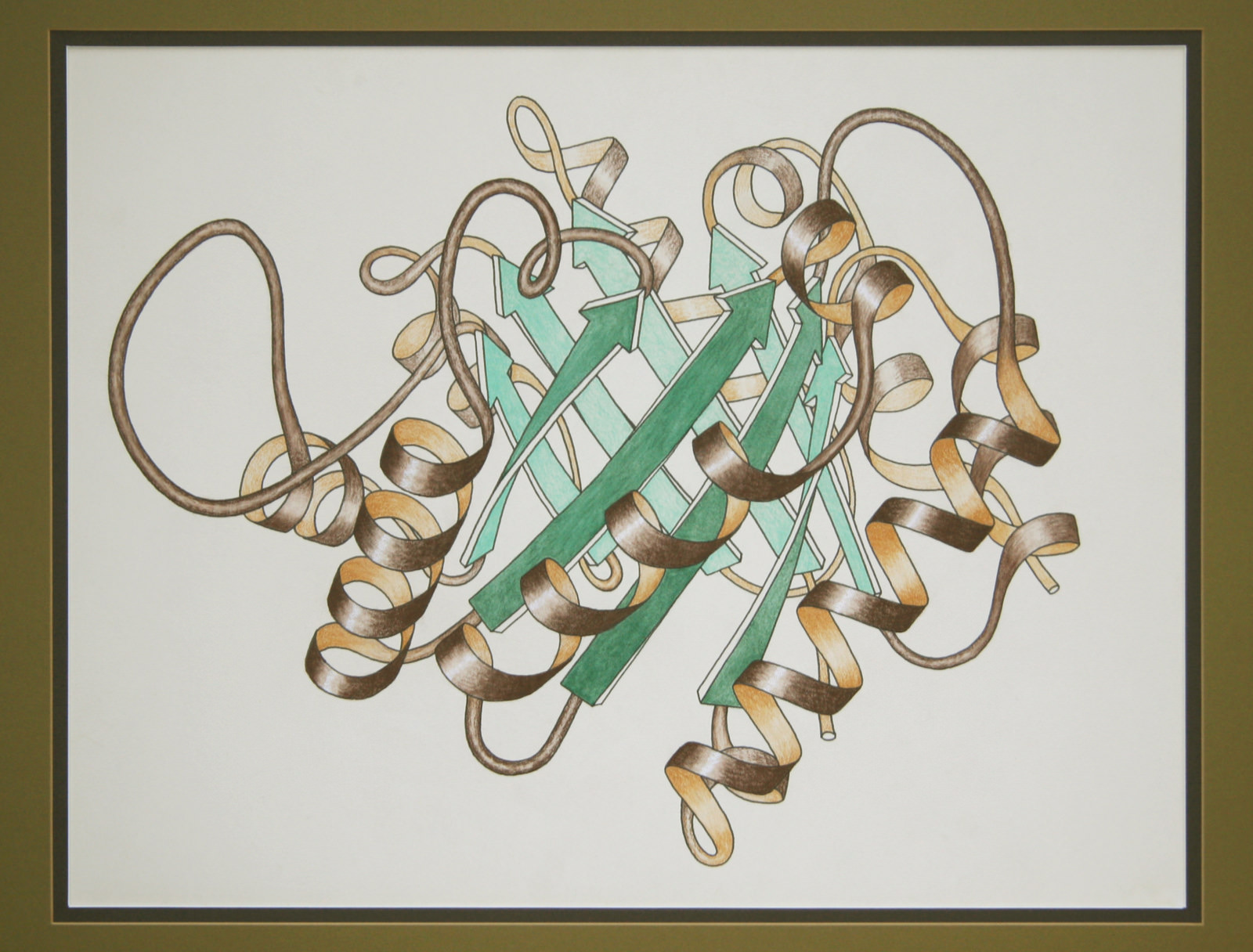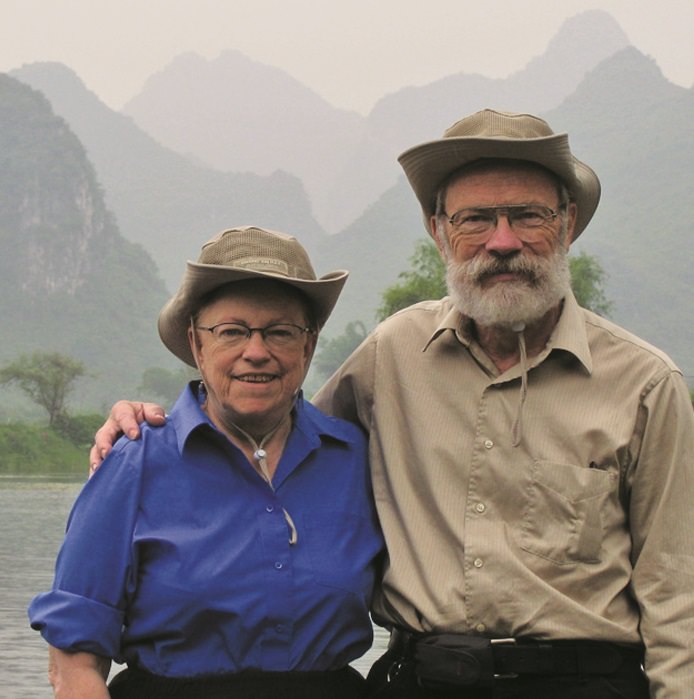Jane Shelby Richardson, James B. Duke Professor of Biochemistry at Duke University and incoming Biophysical Society President, is the exception to the rule when it comes to achieving a successful career in the sciences. With a master’s degree in philosophy, three honorary degrees, and a lifelong fascination with astronomy, math, physics, and botany, Jane has relied on brains, hard work, and close collaborations to build one of the most influential careers in the biophysical community.
The daughter of an electrical engineer and a literature and composition teacher, Jane gleaned math skills, writing skills, and a love of carpentry, hiking, and traveling from her parents, who took her and her sister on country-wide driving trips. A passion for astronomy blossomed in Jane from third-grade visits to Hayden Planetarium. She grew up counting meteors and watching for supernovae, building her own 6” telescope, and traveling to see a solar eclipse. Her Teaneck, New Jersey, high school afforded access to amateur astronomy groups, both there and in nearby New York City. At 17, naked-eye observations of Sputnik by Jane and a few astronomically inclined friends, and her calculation of its orbit, earned her third place in the Westinghouse Science Talent Search, a forerunner of the highly competitive Intel International Science & Engineering Fair.
Jane turned her interest in math and astronomy into a BA in philosophy from Swarthmore College, “which I’ve found very useful, since it teaches you to question assumptions,” she says. On leaving Harvard with a masters in philosophy, Jane tried her hand at high-school science teaching. Concluding it wasn’t for her, she became a technician in the lab at MIT where her husband Dave was working on his PhD. When she joined him in his research on the crystal structure of Staphylococcal nuclease, it was just the beginning. “We spent seven years happily reverse-engineering how the first ones had been done, and in 1969 tied with cytochrome C for the tenth distinct protein solved,” she says. “We’ve worked together ever since.”
Don't be afraid to go in new directions. Share, collaborate, and give away ideas and results freely.
- Richardson
While she worked alongside her husband in their lab at Duke, her latent artistic talent emerged as Jane began comparing and drawing protein structures. Working on top of Ca-trace stereos, she drew ribbon representations of the 3D relationships for every protein known at the time. These ribbon schematics of proteins have become universally recognizable among scientists, even iconic. In the late 1980s they were translated into computer graphics by Mike Carson, Dave Richardson, and others. Frederick Brooks, Jr., current Kenan Professor of Computer Science and founder of the Department of Computer Science at UNC Chapel Hill, has worked with the Richardsons for three decades, developing what he refers to as computer-science toolsmithing, and defines as developing interactive computer graphics hardware, software, and techniques for aiding scientific discovery. “Since Jane had pioneered a new way of drawing protein structures, her ideas on visualization were richly developed,” says Brooks. “Since in the early days she had drawn with her own pencil structures of all the then-known proteins, she had developed a deep knowledge of what structures existed and a keen instinct for structure validity. She would often say of a postulated structure, ‘That’s not proteiny.’ She was always right.” One of Jane’s drawings in particular profoundly impacted Patricia Clark, O’Hara Associate Professor & Associate Chair of the Department of Chemistry & Biochemistry at Notre Dame, who was an undergraduate student when she first saw the ribbon diagram. “I had been a chemistry major for almost three years and while I liked it, I had never seen anything inherently beautiful about chemical structures,” Clark recalls. “But that ribbon diagram of triose phosphate isomerase completely knocked my socks off. The idea that that complicated mass of atoms arranged itself into such regular repeating patterns, with such beautiful symmetry, was eye-opening, to say the least.”
When she isn’t staring at the details of protein or RNA structures, Jane works with her husband on computer graphics, structural bioinformatics, protein design, all-atom contacts, and structure validation and improvement. Most recently they are “developing new analyses and methodologies to circumvent current difficulties, such as fitting physically reasonable multiple conformations at very high resolution and achieving good accuracy at low resolution for exciting large complexes and molecular machines,” she says. “We learn and practice through collaborative work on specific important structures, including ribosomes.” Jeremy Block, now a postdoc in the Richardson lab, started there as an undergraduate student, and stayed. “One of the most remarkable things about Jane is that she is a student, teacher, mentor, and colleague all in one bundle of scientific brilliance intermingled with fun and curiosity,” he says. “This characteristic makes her one of the most approachable people I know and serves to empower anyone who interacts with her.” Block himself has worked with the pair on novel methods of visualizing, analyzing, and improving macromolecular structures determined by NMR spectroscopy, using structural bioinformatics and both three-dimensional and virtual reality visualization approaches. “Jane is open to new ideas, to engaging new people, and to thinking in new and exciting ways,” Block says. “Combining openness with the flexibility she and Dave engineer into their lives to respond to new thoughts and ideas is a powerful combination that I think makes their science as fresh now as it has ever been.” Jane herself derives satisfaction from her work “coming up with exciting new ideas and results, jointly with Dave or jointly with our great students,” she says. “Most especially, then, seeing other people take up and use what we’ve discovered or developed.”
 Jane also values the forum for collaboration and openness that the Biophysical Society Annual Meeting provides, which is “very interactive, a good size, and full of varied and productive new ideas,” she says, and “…where even the talks outside my area are usually rewarding and useful in some way, and where there are so many interesting people of all ages to gossip with about science.” Jane herself gave the National Lecture in 1992, for her “an unforgettable and mind-boggling experience.” This year, she will co-chair a session on using Wikipedia, encouraging biophysicists to contribute to this idea-sharing medium and help improve the biophysics-related information there.
Jane also values the forum for collaboration and openness that the Biophysical Society Annual Meeting provides, which is “very interactive, a good size, and full of varied and productive new ideas,” she says, and “…where even the talks outside my area are usually rewarding and useful in some way, and where there are so many interesting people of all ages to gossip with about science.” Jane herself gave the National Lecture in 1992, for her “an unforgettable and mind-boggling experience.” This year, she will co-chair a session on using Wikipedia, encouraging biophysicists to contribute to this idea-sharing medium and help improve the biophysics-related information there.
Between scientific meetings, the Richardson lab is hard at work developing what they see as a key component to the future of biophysics. “We expect to contribute further tools for visualization and critical analysis, and to develop improved strategies for the growing challenge-areas in structural biology: ultra-high resolution, multiple conformations, RNA, and especially large, low-resolution structures,” Jane says. So far, her career path and subsequent successes have equipped her to forcefully impact this diverse, dynamic field. When she assumes the office of Biophysical Society President in late February, she will have yet another opportunity to do just that.